|
 This article entitled "The Boom in
R/C Boats" appeared in the June 1955 edition of Popular Electronics
magazine which, during the early years of its existence devoted quite a bit of print
space to radio control airplanes, boats and cars. As with all things electronics,
a huge surge in consumer interest was occurring with over-the-air communications.
Bill (William) Winter served as the editor of the Academy of Model Aeronautics'
(AMA's) American Modeler and American Aircraft Modeler magazines
from 1966 through 1974, but his efforts to promote all form of modeling - airplanes,
helicopters, cars, boats, trains, and rockets - covered many decades. His first
recorded article, "Building the Famous Udet Flamingo," (co-authored by Walter McBride),
was published in the March 1935 issue of Universal Model Airplane News
magazine... This article entitled "The Boom in
R/C Boats" appeared in the June 1955 edition of Popular Electronics
magazine which, during the early years of its existence devoted quite a bit of print
space to radio control airplanes, boats and cars. As with all things electronics,
a huge surge in consumer interest was occurring with over-the-air communications.
Bill (William) Winter served as the editor of the Academy of Model Aeronautics'
(AMA's) American Modeler and American Aircraft Modeler magazines
from 1966 through 1974, but his efforts to promote all form of modeling - airplanes,
helicopters, cars, boats, trains, and rockets - covered many decades. His first
recorded article, "Building the Famous Udet Flamingo," (co-authored by Walter McBride),
was published in the March 1935 issue of Universal Model Airplane News
magazine...
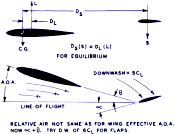 It would be interesting to do a side-by-side
comparison on what was considered engineered
control line
stunt model airplane design in 1957, when this article was written, to what
is today considered to be optimal design criteria. I am trying to get back into
control line stunt flying and have one model built currently, the Enterprise-E.
It has been flown a few times and is (was) extremely sensitive on the controls when
set up per the plans. A little bit of control handle movements resulted in a huge
amount of both elevator and flap deflection. Fortunately, access to the flap control
horn is available through the removable top fuselage hatch, so I was able to relocate
the pushrod from the bellcrank to the flap horn, and then from the flap horn... It would be interesting to do a side-by-side
comparison on what was considered engineered
control line
stunt model airplane design in 1957, when this article was written, to what
is today considered to be optimal design criteria. I am trying to get back into
control line stunt flying and have one model built currently, the Enterprise-E.
It has been flown a few times and is (was) extremely sensitive on the controls when
set up per the plans. A little bit of control handle movements resulted in a huge
amount of both elevator and flap deflection. Fortunately, access to the flap control
horn is available through the removable top fuselage hatch, so I was able to relocate
the pushrod from the bellcrank to the flap horn, and then from the flap horn...
 When Melanie and I got married in 1983,
part of her dowry included some of the toys she had as a little girl. A
Hasbro Lite-Brite
was one of them. Our kids played with it when they were young, but somewhere along
the line during our many household moves, it disappeared. We probably donated it
to the Salvation Army at some point - a lot of our stuff has ended up there. About
a month ago we started watching for a good one on eBay that didn't cost too much.
Finally, there was a 1967-vintage Lite-Brite in like-new condition up for auction
that we got for around $45. It has a nice box... When Melanie and I got married in 1983,
part of her dowry included some of the toys she had as a little girl. A
Hasbro Lite-Brite
was one of them. Our kids played with it when they were young, but somewhere along
the line during our many household moves, it disappeared. We probably donated it
to the Salvation Army at some point - a lot of our stuff has ended up there. About
a month ago we started watching for a good one on eBay that didn't cost too much.
Finally, there was a 1967-vintage Lite-Brite in like-new condition up for auction
that we got for around $45. It has a nice box...
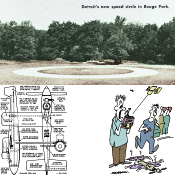 Per "Wild Bill" Netzenband's report in this
1961 issue of American Modeler magazine covered the Vancouver Bi-Liners,
MAC highlights, Alan Nichols' success in Thompson Trophy Racer events, encouraging
clubs to adopt the affordable, and slow-flying contests. He addresses backlogged
club crest submissions, noting the impracticality of featuring all due to volume.
Alan Nichols debunks the myth that models wear out quickly, citing his year-old
Nobler and a five-year-old Fierce Arrow with original engine. Memories resurface
of McDonnell Aircraft's picnic air shows, where Phil Hamm's reliable metal jet stood
out. Southern California's new Control-Line Association, led by John Gudvangan and
others, seeks enthusiasts. Detroit's Metropolitan Speed Association unveils an $8,000
Rouge Park speed circle, aiming for a competitive... Per "Wild Bill" Netzenband's report in this
1961 issue of American Modeler magazine covered the Vancouver Bi-Liners,
MAC highlights, Alan Nichols' success in Thompson Trophy Racer events, encouraging
clubs to adopt the affordable, and slow-flying contests. He addresses backlogged
club crest submissions, noting the impracticality of featuring all due to volume.
Alan Nichols debunks the myth that models wear out quickly, citing his year-old
Nobler and a five-year-old Fierce Arrow with original engine. Memories resurface
of McDonnell Aircraft's picnic air shows, where Phil Hamm's reliable metal jet stood
out. Southern California's new Control-Line Association, led by John Gudvangan and
others, seeks enthusiasts. Detroit's Metropolitan Speed Association unveils an $8,000
Rouge Park speed circle, aiming for a competitive...
 This article entitled "Why Pilots Will Matter
in the Age of
Autonomous Planes" appeared in the June 2025 issue of IEEE's Spectrum
magazine. "Long after planes start flying themselves, humans will still be in the
loop. In August 2001, an anonymous guest posted on the forum at Airliners.net, a
popular aviation website. 'How Long Will Pilots Be Needed?' they wondered, observing
that '20 years or so down the road' technology could be so advanced that planes
would fly themselves. 'So would it really be useful for a person to go to college
now and be an airline pilot if a few years down the road they will be phased out
by technology?' Twenty-four years later, the basic technology required to make aircraft
fly themselves exists, as evidenced by the fact that most commercial flights are
flown largely on autopilot..." This article entitled "Why Pilots Will Matter
in the Age of
Autonomous Planes" appeared in the June 2025 issue of IEEE's Spectrum
magazine. "Long after planes start flying themselves, humans will still be in the
loop. In August 2001, an anonymous guest posted on the forum at Airliners.net, a
popular aviation website. 'How Long Will Pilots Be Needed?' they wondered, observing
that '20 years or so down the road' technology could be so advanced that planes
would fly themselves. 'So would it really be useful for a person to go to college
now and be an airline pilot if a few years down the road they will be phased out
by technology?' Twenty-four years later, the basic technology required to make aircraft
fly themselves exists, as evidenced by the fact that most commercial flights are
flown largely on autopilot..."
 This is the February 8, 1942, "Flyin' Jenny" comic strip. The Baltimore Sun newspaper, published
not far from where I grew up near Annapolis, Maryland, carried "Flyin' Jenny" from
the late 1930s until the strip ended in the mid 1940s, so I saved a couple dozen
from there. The first one I downloaded has a publication date of December 7, 1941
- that date "which will live in infamy," per President Roosevelt. Many Americans
were receiving word over the radio of the Japanese attack on Pearl Harbor while
reading this comic at the breakfast table. I expect that soon there will be World
War II themes. "Flyin' Jenny," whose real name was Virginia Dare (what's in
a name?), was a test pilot for Starcraft Aviation Factory who divided her time between
wringing out new airplane designs and chasing bad guys. She was the creation of
artist and storyteller Russell Keaton... This is the February 8, 1942, "Flyin' Jenny" comic strip. The Baltimore Sun newspaper, published
not far from where I grew up near Annapolis, Maryland, carried "Flyin' Jenny" from
the late 1930s until the strip ended in the mid 1940s, so I saved a couple dozen
from there. The first one I downloaded has a publication date of December 7, 1941
- that date "which will live in infamy," per President Roosevelt. Many Americans
were receiving word over the radio of the Japanese attack on Pearl Harbor while
reading this comic at the breakfast table. I expect that soon there will be World
War II themes. "Flyin' Jenny," whose real name was Virginia Dare (what's in
a name?), was a test pilot for Starcraft Aviation Factory who divided her time between
wringing out new airplane designs and chasing bad guys. She was the creation of
artist and storyteller Russell Keaton...
 This is the complete set of
Peanuts Skediddlers,
sold by Mattel. Linus is extremely difficult to find, and when you do, he typically
sells for $200 or more. If you find a Linus Skediddler with the original box, expect
to pay $400. Over time, our (Melanie and me) Peanuts collection of memorabilia has
grow from the few items she had left over from her girlhood to complete sets. Everything
was gotten via eBay auctions. It took a lot of patience to be able to get good quality
items at an affordable price. Here is a bit of history I gathered on the Skediddlers.
Phenomenon: In the mid-to-late 1960s, Mattel capitalized on the explosive popularity
of Charles M. Schulz's Peanuts comic strip by releasing the Skediddler - a line
of friction-powered toys. Unlike wind-up mechanisms, these toys relied on a simple
push-and-go design: sliding them across a surface activated internal gears, causing
the characters' limbs and heads to jerk in a whimsical "skedaddling"... This is the complete set of
Peanuts Skediddlers,
sold by Mattel. Linus is extremely difficult to find, and when you do, he typically
sells for $200 or more. If you find a Linus Skediddler with the original box, expect
to pay $400. Over time, our (Melanie and me) Peanuts collection of memorabilia has
grow from the few items she had left over from her girlhood to complete sets. Everything
was gotten via eBay auctions. It took a lot of patience to be able to get good quality
items at an affordable price. Here is a bit of history I gathered on the Skediddlers.
Phenomenon: In the mid-to-late 1960s, Mattel capitalized on the explosive popularity
of Charles M. Schulz's Peanuts comic strip by releasing the Skediddler - a line
of friction-powered toys. Unlike wind-up mechanisms, these toys relied on a simple
push-and-go design: sliding them across a surface activated internal gears, causing
the characters' limbs and heads to jerk in a whimsical "skedaddling"...
 This 1949 Air Trails magazine article
warns that the
Soviet
Union has surpassed the U.S. in military aircraft production by a 15-to-1 margin,
with advanced jet fighters, bombers, and long-range piston-engine planes already
operational. Soviet scientists have also conducted atomic tests and are close to
producing compact A-bombs. Intelligence reveals a Red Air Force of 15,000 first-line
aircraft, including 2,400 jets, some surpassing American designs. The Soviets broke
the sound barrier before the U.S. and have developed powerful turbojet engines,
some with innovative features like variable-pitch stators. German scientists and
captured technology accelerated Soviet progress, particularly in rocketry and jet
propulsion. Their aircraft feature advanced construction techniques, such as metal-plywood
sandwich wings, and superior armament... This 1949 Air Trails magazine article
warns that the
Soviet
Union has surpassed the U.S. in military aircraft production by a 15-to-1 margin,
with advanced jet fighters, bombers, and long-range piston-engine planes already
operational. Soviet scientists have also conducted atomic tests and are close to
producing compact A-bombs. Intelligence reveals a Red Air Force of 15,000 first-line
aircraft, including 2,400 jets, some surpassing American designs. The Soviets broke
the sound barrier before the U.S. and have developed powerful turbojet engines,
some with innovative features like variable-pitch stators. German scientists and
captured technology accelerated Soviet progress, particularly in rocketry and jet
propulsion. Their aircraft feature advanced construction techniques, such as metal-plywood
sandwich wings, and superior armament...
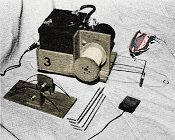 A long time ago (circa
1977) I bought a used glider winch at an auction held by the Prince Georges Radio
Club, in Maryland. It cost me somewhere around $25, which was a lot for me in the
mid 1970s. The motor and control circuitry was contained in a plywood box, with
a jack for the foot switch and terminals to clamp jumper cable to from a car. In
looking at these plans for the
AAM Glider Winch shown
here from the April 1973 American Aircraft Modeler, it looks a lot like mine, only
mine was in a wooden box. It worked extremely well for my 99"
Windfree and 99"
Aquila sailplanes. Unfortunately,
I sold it shortly after getting married in 1983 (couldn't eat the winch). I would
love to have it back. Actually, what I would rather have at this point is a winch
that is powered by a cordless drill that would be lighter... A long time ago (circa
1977) I bought a used glider winch at an auction held by the Prince Georges Radio
Club, in Maryland. It cost me somewhere around $25, which was a lot for me in the
mid 1970s. The motor and control circuitry was contained in a plywood box, with
a jack for the foot switch and terminals to clamp jumper cable to from a car. In
looking at these plans for the
AAM Glider Winch shown
here from the April 1973 American Aircraft Modeler, it looks a lot like mine, only
mine was in a wooden box. It worked extremely well for my 99"
Windfree and 99"
Aquila sailplanes. Unfortunately,
I sold it shortly after getting married in 1983 (couldn't eat the winch). I would
love to have it back. Actually, what I would rather have at this point is a winch
that is powered by a cordless drill that would be lighter...
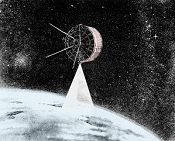 We take for granted most of the technology
that surrounds us. Unless you were alive 60 years ago at the dawn of microelectronics
and space flight, it would be difficult to imagine a world without cellphones, desktop
computers, color TVs, the Internet, and even
satellite-base weather forecasting. Everyone likes to make jokes about weathermen
being no better at predicting the weather than your grandmother's roomatiz[sic],
but the fact is that, especially for short-term (2-3 days) predictions, we get pretty
good information. As a model airplane flyer, I check the wind level forecast nearly
every day to see whether my model plane can handle it. AccuWeather's free hourly
forecast is usually pretty darn accurate for today's and tomorrow's wind... We take for granted most of the technology
that surrounds us. Unless you were alive 60 years ago at the dawn of microelectronics
and space flight, it would be difficult to imagine a world without cellphones, desktop
computers, color TVs, the Internet, and even
satellite-base weather forecasting. Everyone likes to make jokes about weathermen
being no better at predicting the weather than your grandmother's roomatiz[sic],
but the fact is that, especially for short-term (2-3 days) predictions, we get pretty
good information. As a model airplane flyer, I check the wind level forecast nearly
every day to see whether my model plane can handle it. AccuWeather's free hourly
forecast is usually pretty darn accurate for today's and tomorrow's wind...
 In this 1937 "Smoke Scream" in a 1937 issue
of Flying Aces magazine, by Joe Archibald,
Lt. Phineas
Pinkham, the 9th Pursuit Squadron's resident troublemaker, stumbles into chaos
when he encounters an elephant named Hungha Tin and its Hindu mahout. After the
elephant drinks a bottle of arnica meant for a local's backache, it goes berserk,
wreaking havoc across the Allied camp. Meanwhile, Brigadier Scruggs confesses to
Pinkham that he sleepwalked and handed top-secret battle plans to an unknown spy.
Pinkham, framed by the mahout - who's actually a German agent - unknowingly smokes
a drugged cigarette and nearly flies a stolen Spad to the enemy. The vengeful elephant
interrupts his forced defection, allowing Pinkham to escape with Hauptmann von Spieler
as his prisoner. Back at base, Pinkham... In this 1937 "Smoke Scream" in a 1937 issue
of Flying Aces magazine, by Joe Archibald,
Lt. Phineas
Pinkham, the 9th Pursuit Squadron's resident troublemaker, stumbles into chaos
when he encounters an elephant named Hungha Tin and its Hindu mahout. After the
elephant drinks a bottle of arnica meant for a local's backache, it goes berserk,
wreaking havoc across the Allied camp. Meanwhile, Brigadier Scruggs confesses to
Pinkham that he sleepwalked and handed top-secret battle plans to an unknown spy.
Pinkham, framed by the mahout - who's actually a German agent - unknowingly smokes
a drugged cigarette and nearly flies a stolen Spad to the enemy. The vengeful elephant
interrupts his forced defection, allowing Pinkham to escape with Hauptmann von Spieler
as his prisoner. Back at base, Pinkham...
 The Academy of Model Aeronautics is granted
tax-exempt status because part of its charter is for activity as an educational
organization. I think as time goes on, it gets harder for the AMA for fulfill that
part of its mission because presenting anything even vaguely resembling mathematics
or science to kids (or to most adults for that matter), is the kiss of death for
gaining or retaining interest. This article, "Control-Line
Aerodynamics Made Painless," was printed in the December 1967 edition of
American Modeler magazine, when graphs, charts, and equations were not eschewed
by modelers. It is awesome. On rare occasions a similar type article will appear
nowadays in Model Aviation magazine for topics like basic aerodynamics and battery
/ motor parameters. Nowadays, it seems, the most rigorous classroom material that
the AMA can manage to slip into schools is a box of gliders and a PowerPoint presentation... The Academy of Model Aeronautics is granted
tax-exempt status because part of its charter is for activity as an educational
organization. I think as time goes on, it gets harder for the AMA for fulfill that
part of its mission because presenting anything even vaguely resembling mathematics
or science to kids (or to most adults for that matter), is the kiss of death for
gaining or retaining interest. This article, "Control-Line
Aerodynamics Made Painless," was printed in the December 1967 edition of
American Modeler magazine, when graphs, charts, and equations were not eschewed
by modelers. It is awesome. On rare occasions a similar type article will appear
nowadays in Model Aviation magazine for topics like basic aerodynamics and battery
/ motor parameters. Nowadays, it seems, the most rigorous classroom material that
the AMA can manage to slip into schools is a box of gliders and a PowerPoint presentation...
 Peter Bowers first became know to me because
of his Fly Baby homebuilt airplane. It won the
Experimental
Aircraft Association (EAA) design contest in 1962. Back in the middle and late
1970s, I was taking flying lessons and dreaming big about building my own aerobatic
biplane. Being an avid woodworker, the Fly Baby appealed to me because it was constructed
entirely of wood, except for a few critical metal fittings. My plan was to build
the biplane version of the Fly Baby. Like so many other things, the aeroplane never
got built. Peter Bowers was not only an aeronautical engineer and airplane designer
but also an aviation historian and model airplane enthusiast... Peter Bowers first became know to me because
of his Fly Baby homebuilt airplane. It won the
Experimental
Aircraft Association (EAA) design contest in 1962. Back in the middle and late
1970s, I was taking flying lessons and dreaming big about building my own aerobatic
biplane. Being an avid woodworker, the Fly Baby appealed to me because it was constructed
entirely of wood, except for a few critical metal fittings. My plan was to build
the biplane version of the Fly Baby. Like so many other things, the aeroplane never
got built. Peter Bowers was not only an aeronautical engineer and airplane designer
but also an aviation historian and model airplane enthusiast...
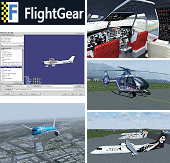 "FlightGear" is an Open Source (aka
Free) flight simulator program which I first wrote about in 2012. It has come a
long way - and was pretty dran good, aven back then - and is now a viable competitor
for Microsoft's Flight Simulator (MSFS). The leatest release as of this writing
is 2024.1.1. The graphics are superb and easily on par with MSFS. FlightGear has
a joystick interface, but I don't own a joystick, so my experience with it using
keyboard inputs. VR headsets are also supported now. The basic download comes with
a couple dozen aircraft, and there are many additional models available as separate
downloads. FlightGear runs on Windows, macOS and Linux. Thanks to all the folks
who have spent their valuable time developing FlightGear! FlightGear website: "FlightGear
is an open-source flight simulator. It supports a variety of popular platforms (Windows,
Mac, Linux, etc.) and is developed by skilled volunteers from around the world... "FlightGear" is an Open Source (aka
Free) flight simulator program which I first wrote about in 2012. It has come a
long way - and was pretty dran good, aven back then - and is now a viable competitor
for Microsoft's Flight Simulator (MSFS). The leatest release as of this writing
is 2024.1.1. The graphics are superb and easily on par with MSFS. FlightGear has
a joystick interface, but I don't own a joystick, so my experience with it using
keyboard inputs. VR headsets are also supported now. The basic download comes with
a couple dozen aircraft, and there are many additional models available as separate
downloads. FlightGear runs on Windows, macOS and Linux. Thanks to all the folks
who have spent their valuable time developing FlightGear! FlightGear website: "FlightGear
is an open-source flight simulator. It supports a variety of popular platforms (Windows,
Mac, Linux, etc.) and is developed by skilled volunteers from around the world...
 The October 1950 Air Trails magazine
showcases
modelers' innovations, including H.G. Oliver's Plexiglas skids for speed models
and Don Nelson's booster battery setup. Ray Biernacki suggests keeping brushes soft
with thinner fumes, while Richard Larson offers a footswitch for bench testing.
Ted Jones improves dethermalizer safety, and Charles Francis simplifies its design.
Willard Hafler's flying wing excels in speed and sport flying, and Leon Shulman
repurposes a crankcase recess as a fuel tank. The magazine encourages readers to
submit their own ideas, paying $2 per accepted sketch. These practical, cost-saving
solutions highlight the creativity of mid-century model aviation enthusiasts, blending
engineering ingenuity with accessible materials - a snapshot of hobbyist innovation
in postwar America... The October 1950 Air Trails magazine
showcases
modelers' innovations, including H.G. Oliver's Plexiglas skids for speed models
and Don Nelson's booster battery setup. Ray Biernacki suggests keeping brushes soft
with thinner fumes, while Richard Larson offers a footswitch for bench testing.
Ted Jones improves dethermalizer safety, and Charles Francis simplifies its design.
Willard Hafler's flying wing excels in speed and sport flying, and Leon Shulman
repurposes a crankcase recess as a fuel tank. The magazine encourages readers to
submit their own ideas, paying $2 per accepted sketch. These practical, cost-saving
solutions highlight the creativity of mid-century model aviation enthusiasts, blending
engineering ingenuity with accessible materials - a snapshot of hobbyist innovation
in postwar America...
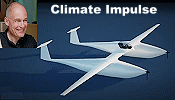 "IEEE Spectrum interviewed Bertrand Piccard
at a pivotal moment in the hydrogen-powered aircraft project, with the plane, called
Climate Impulse,
about 40 percent built. Piccard spoke about the contributions of his corporate sponsors,
including Airbus, to the Climate Impulse project and about why he's confident that
hydrogen will eventually succeed as an aviation fuel. He'll fly around the world
in a hydrogen fuel-cell aircraft. Few explorers have reached the heights, literally
and figuratively, that Bertrand Piccard has. He is the quintessential modern explorer,
for whom every big mission has a purpose, which generally boils down to environmental
and climate-change awareness. In 1999, he was the first person to circumnavigate..." "IEEE Spectrum interviewed Bertrand Piccard
at a pivotal moment in the hydrogen-powered aircraft project, with the plane, called
Climate Impulse,
about 40 percent built. Piccard spoke about the contributions of his corporate sponsors,
including Airbus, to the Climate Impulse project and about why he's confident that
hydrogen will eventually succeed as an aviation fuel. He'll fly around the world
in a hydrogen fuel-cell aircraft. Few explorers have reached the heights, literally
and figuratively, that Bertrand Piccard has. He is the quintessential modern explorer,
for whom every big mission has a purpose, which generally boils down to environmental
and climate-change awareness. In 1999, he was the first person to circumnavigate..."
 Amazingly, even during the Cold War years
it was not uncommon to see aircraft modelers from the "Iron Curtain"
countries participating in international contests. Even Commies like flying model
airplanes. Because their societies and politics were so closed and guarded, getting
information about their modeling supplies was darn near impossible except during
events where inspection could be made. Being a generally friendly bunch of guys,
the modelers would share their designs with the Free World, and vice versa. Then,
in subsequent years the Commies would show up with equipment that was exact replicas
of ours - copyrights and trademarks held no legal weight behind the Iron Curtain.
Truth be know, most or all of the participants were probably KGB agents (or other
Commie country equivalents) engaging... Amazingly, even during the Cold War years
it was not uncommon to see aircraft modelers from the "Iron Curtain"
countries participating in international contests. Even Commies like flying model
airplanes. Because their societies and politics were so closed and guarded, getting
information about their modeling supplies was darn near impossible except during
events where inspection could be made. Being a generally friendly bunch of guys,
the modelers would share their designs with the Free World, and vice versa. Then,
in subsequent years the Commies would show up with equipment that was exact replicas
of ours - copyrights and trademarks held no legal weight behind the Iron Curtain.
Truth be know, most or all of the participants were probably KGB agents (or other
Commie country equivalents) engaging...
|
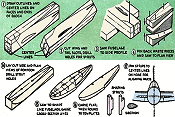 With the entry of the United States into
World War II came the need for service members to be trained on many new technologies
- among them being airplanes and the ability to identify them quickly. Electronics
technicians and airframe and powerplant mechanics were in need, of course, but everyone
had to be able to tell friend from foe when airplanes were approaching. In order
to assist the war effort, a call went out to civilians to begin producing thousands
of
models at a 1:72 scale so that at 35 feet away they appeared in
size to be that of a full-scale version at about half a mile. Detailed paint jobs
were not required - only that the profile from all angles look exactly like the
real thing. In fact, the models were painted flat black so as to look like a distant
airplane against the background sky. Both Allied and Axis airplane models were needed
so that soldiers and sailors could quickly spot a potential danger and decide whether
to take cover and prepare to fight, or to continue with business as usual. This
article appeared in the May 1942 edition of Popular Science, meaning that it was
probably written sometime around February, only a few months after the Japanese
attacked our naval base at Pearl Harbor, Hawaii, on December 7, 1941... With the entry of the United States into
World War II came the need for service members to be trained on many new technologies
- among them being airplanes and the ability to identify them quickly. Electronics
technicians and airframe and powerplant mechanics were in need, of course, but everyone
had to be able to tell friend from foe when airplanes were approaching. In order
to assist the war effort, a call went out to civilians to begin producing thousands
of
models at a 1:72 scale so that at 35 feet away they appeared in
size to be that of a full-scale version at about half a mile. Detailed paint jobs
were not required - only that the profile from all angles look exactly like the
real thing. In fact, the models were painted flat black so as to look like a distant
airplane against the background sky. Both Allied and Axis airplane models were needed
so that soldiers and sailors could quickly spot a potential danger and decide whether
to take cover and prepare to fight, or to continue with business as usual. This
article appeared in the May 1942 edition of Popular Science, meaning that it was
probably written sometime around February, only a few months after the Japanese
attacked our naval base at Pearl Harbor, Hawaii, on December 7, 1941...
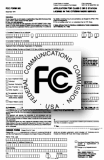 If you have only ever known a time in the
R/C era when 2.4 GHz, spread spectrum radios were in use and not only were
there no interference issues, but there were no licenses required, either, for legal
operation, then it might be hard to imagine when this was not so. Most people in
the R/C realm at least remember the 72 MHz frequency band where each system
operated on a specific center frequency, where no two systems could be operated
in the same vicinity. Before that there was the 27 MHz band, which is where
I began, more specifically on 27.195 MHz. Only five frequencies were reserved
by the FCC exclusively for radio control use. That meant never more than five planes
in the air, or even being worked on with the radio on, at a time. The band was part
of the original Citizens Band (CB) radio allocation. Commercial CB radios were notoriously
lousy at controlling bandwidth and often overlapped the R/C bands with enough power
to cause deadly (to a model) interference. My FCC operator's permits (Class
C and Class D), obtained sometime around 1972, is long gone... If you have only ever known a time in the
R/C era when 2.4 GHz, spread spectrum radios were in use and not only were
there no interference issues, but there were no licenses required, either, for legal
operation, then it might be hard to imagine when this was not so. Most people in
the R/C realm at least remember the 72 MHz frequency band where each system
operated on a specific center frequency, where no two systems could be operated
in the same vicinity. Before that there was the 27 MHz band, which is where
I began, more specifically on 27.195 MHz. Only five frequencies were reserved
by the FCC exclusively for radio control use. That meant never more than five planes
in the air, or even being worked on with the radio on, at a time. The band was part
of the original Citizens Band (CB) radio allocation. Commercial CB radios were notoriously
lousy at controlling bandwidth and often overlapped the R/C bands with enough power
to cause deadly (to a model) interference. My FCC operator's permits (Class
C and Class D), obtained sometime around 1972, is long gone...
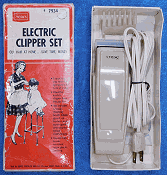 In my zeal to procure some of the items
I remember having or using as a kid in the 1960s and '70s, along with some of the
things Melanie and I had when we first got married back in 1983, I ran across this
Sears Electric Clipper Set
(#7934) on eBay. The seller was only asking about $10 for it, so here it is. As
you can see in the photos, it is in mint condition, and even the original box shows
only minor wear and tear from sitting in someone's closet for more than half a century.
I disassembled the clippers and did a thorough cleaning (not much there) and oiled
the moving parts with a bit of 3-in-1. Everything seems to be in great condition.
Even the power cord is supple and unscathed. One of the plastic blade attachments
was included, although the instruction sheet shows four types. Judging from other
similar clippers for sale on eBay, the set only came with one, and the other styles
must have been available for purchase separately. If you have any you can bear to
part with, please let me know... In my zeal to procure some of the items
I remember having or using as a kid in the 1960s and '70s, along with some of the
things Melanie and I had when we first got married back in 1983, I ran across this
Sears Electric Clipper Set
(#7934) on eBay. The seller was only asking about $10 for it, so here it is. As
you can see in the photos, it is in mint condition, and even the original box shows
only minor wear and tear from sitting in someone's closet for more than half a century.
I disassembled the clippers and did a thorough cleaning (not much there) and oiled
the moving parts with a bit of 3-in-1. Everything seems to be in great condition.
Even the power cord is supple and unscathed. One of the plastic blade attachments
was included, although the instruction sheet shows four types. Judging from other
similar clippers for sale on eBay, the set only came with one, and the other styles
must have been available for purchase separately. If you have any you can bear to
part with, please let me know...
 Airplanes and Rockets website visitor Lars
B. wrote from Sweden requesting that I scan this "Wind Flying" article from
the September 1972 edition of American Aircraft Modeler magazine. It describes
a method for replacing engines and motors with human power for preforming some pretty
impressive C/L aerobatics on windy days. Basically, you drag the model airplane
around on its control lines, which often required not just turning in a circle while
standing in one place, but walking around a small circle in order to get more speed.
If there is any wind, you need to put extra effort into the pulling when moving
into the wind. I can remember doing this as a teenager, only I did it with the engine
in place but not running - usually because I could not afford to buy enough fuel
to fly as often as preferred... Airplanes and Rockets website visitor Lars
B. wrote from Sweden requesting that I scan this "Wind Flying" article from
the September 1972 edition of American Aircraft Modeler magazine. It describes
a method for replacing engines and motors with human power for preforming some pretty
impressive C/L aerobatics on windy days. Basically, you drag the model airplane
around on its control lines, which often required not just turning in a circle while
standing in one place, but walking around a small circle in order to get more speed.
If there is any wind, you need to put extra effort into the pulling when moving
into the wind. I can remember doing this as a teenager, only I did it with the engine
in place but not running - usually because I could not afford to buy enough fuel
to fly as often as preferred...
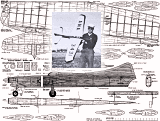 The Jetco Shark 15 was my very first
built up control line airplane. Before that they had all been plastic Cox models.
As did many kids in the 1960's and 1970's I learned to fly on a Cox PT−19 Trainer
(summer of 1969, about the time Apollo 11 landed on the moon). Before building
the Shark 15, my experience with built-up models was with rubber-powered free
flight. Mustering enough money for a Shark 15, a Fox 15 C/L engine, and
covering materials was not easy in those days. The Shark 15 flew very nicely
when I could get the Fox 15 started and running properly. Loops, wingovers,
and inverted flight were much more satisfying than with the Cox models, whose .049
engines had a nasty habit of quitting during inverted flight. I resolved to someday
step up to a
Shark 45 once I had enough spare cash, but to this day I still have never
owned one. The largest engine I've ever had on a C/L model was a Fox 35 (equally
temperamental and frustrating) on a Sterling Ringmaster... The Jetco Shark 15 was my very first
built up control line airplane. Before that they had all been plastic Cox models.
As did many kids in the 1960's and 1970's I learned to fly on a Cox PT−19 Trainer
(summer of 1969, about the time Apollo 11 landed on the moon). Before building
the Shark 15, my experience with built-up models was with rubber-powered free
flight. Mustering enough money for a Shark 15, a Fox 15 C/L engine, and
covering materials was not easy in those days. The Shark 15 flew very nicely
when I could get the Fox 15 started and running properly. Loops, wingovers,
and inverted flight were much more satisfying than with the Cox models, whose .049
engines had a nasty habit of quitting during inverted flight. I resolved to someday
step up to a
Shark 45 once I had enough spare cash, but to this day I still have never
owned one. The largest engine I've ever had on a C/L model was a Fox 35 (equally
temperamental and frustrating) on a Sterling Ringmaster...
 It is hard to imagine how pilots managed
to find their way through fog, rain, sleet, and snow prior to the advent of instruments
that could indicate whether the airplane was flying straight and level or spiraling
toward the ground. Some flyers were good enough in most situations to sense attitude
even without an outside-the-cockpit visual clue. However, it is entirely possible
to enter into a situation where your senses cannot possibly tell the difference
between normal flight and a life threatening scenario. Albert Einstein's General
Theory of Relativity tells us that without knowing otherwise, there is no discernable
difference between gravity and physical acceleration. Therefore, a pilot in solid
Instrument Flight Rules (IFR) conditions where he cannot see the
sky or ground could very well mistake ... It is hard to imagine how pilots managed
to find their way through fog, rain, sleet, and snow prior to the advent of instruments
that could indicate whether the airplane was flying straight and level or spiraling
toward the ground. Some flyers were good enough in most situations to sense attitude
even without an outside-the-cockpit visual clue. However, it is entirely possible
to enter into a situation where your senses cannot possibly tell the difference
between normal flight and a life threatening scenario. Albert Einstein's General
Theory of Relativity tells us that without knowing otherwise, there is no discernable
difference between gravity and physical acceleration. Therefore, a pilot in solid
Instrument Flight Rules (IFR) conditions where he cannot see the
sky or ground could very well mistake ...
 I just made a short video of my
Blade 230 S SMART helicopter
in flight to demonstrate how easy it is to fly in the Stability Mode (I've not tried
to fly in the Agility Mode). Easy, that is, after a trial−and−error method of programming
the Spektrum DX6 G3 transmitter. The setting shown in the user's manual leaves
the heli way too unstable IMHO. In order to make it trainer-like, I cranked the
servo throws back to 50% (default 100) and turned up the GER setting to 150 (100
default). Also in Forward Programming I set the Stability to 150 (its highest setting).
After that, she hovers hands−off when there's no wind. I had
Blade 230 S V2
prior to this (sold it), and it flew fine in Stability Mode using the manual's settings,
so something's different with the SAFE version. I was about to give up on flying
it until I made the setting adjustments. I might be willing to sell the heli w/training
gear, two 850 mAh Smart batteries and Smart Charger (w/IC2−IC3 adapter) for
$310 (+shipping) if you're interested. Tx not included. I just made a short video of my
Blade 230 S SMART helicopter
in flight to demonstrate how easy it is to fly in the Stability Mode (I've not tried
to fly in the Agility Mode). Easy, that is, after a trial−and−error method of programming
the Spektrum DX6 G3 transmitter. The setting shown in the user's manual leaves
the heli way too unstable IMHO. In order to make it trainer-like, I cranked the
servo throws back to 50% (default 100) and turned up the GER setting to 150 (100
default). Also in Forward Programming I set the Stability to 150 (its highest setting).
After that, she hovers hands−off when there's no wind. I had
Blade 230 S V2
prior to this (sold it), and it flew fine in Stability Mode using the manual's settings,
so something's different with the SAFE version. I was about to give up on flying
it until I made the setting adjustments. I might be willing to sell the heli w/training
gear, two 850 mAh Smart batteries and Smart Charger (w/IC2−IC3 adapter) for
$310 (+shipping) if you're interested. Tx not included.
 "Days of the Americans" is one chapter out
of a book entitled "The Big Distance." Per this article which appeared in the December
1945 issue of Flying Age magazine, "The Big Distance, the official story
prepared by the AAF, is to the struggle in the Pacific what Germany was to the European
phase of the war." Unlike the European Theater of World War II, much of the
populations of South Pacific islands were inhabited by people who were barely out
of the Stone Age in terms of cultural and scientific evolution. The arrival of Northern
hemisphere Western and European Anglo Saxons brought a culture of sophistication
never dreamed of by the backwards civilizations indigenous to the islands. That
was a common theme of the villages visited by the McHale's Navy crew in the 1960s
TV series. While reading the story, I was a bit taken aback by the narrative of
Americans having come to the island paradises and bringing their gigantic machines
and inexplicable habits, but then the author states, "There always will be a faction
among the elders who will attempt to establish the basic facts of the legend of
the Americans through use of pure logic, simply pointing out that if the Americans
had not been there, the Japs still would be. If the Americans weren't actually present,
the question will be posed... "Days of the Americans" is one chapter out
of a book entitled "The Big Distance." Per this article which appeared in the December
1945 issue of Flying Age magazine, "The Big Distance, the official story
prepared by the AAF, is to the struggle in the Pacific what Germany was to the European
phase of the war." Unlike the European Theater of World War II, much of the
populations of South Pacific islands were inhabited by people who were barely out
of the Stone Age in terms of cultural and scientific evolution. The arrival of Northern
hemisphere Western and European Anglo Saxons brought a culture of sophistication
never dreamed of by the backwards civilizations indigenous to the islands. That
was a common theme of the villages visited by the McHale's Navy crew in the 1960s
TV series. While reading the story, I was a bit taken aback by the narrative of
Americans having come to the island paradises and bringing their gigantic machines
and inexplicable habits, but then the author states, "There always will be a faction
among the elders who will attempt to establish the basic facts of the legend of
the Americans through use of pure logic, simply pointing out that if the Americans
had not been there, the Japs still would be. If the Americans weren't actually present,
the question will be posed...
 Imagine if your path to flying an R/C helicopter
involved first designing, then building, and then troubleshooting the contraption.
That was the burden of pioneers. We have people like
S.S.P. Helicopter designer
Gene Rock to thank for being able to enjoy the state-of-the-art models that are
available today. This article from the August 1972 edition of American Aircraft
Modeler magazine describes the process of machining all the metal parts for
an Enya .45-powered craft. Mr. Rock even designed a very successful mechanical gyro
for keeping the tail under control. If you have ever tried flying an R/C heli without
any type of gyro (I have, on a DuBro Tristar), you will fully appreciate what a
pleasure it is to not have to manually counter torque changes (throttle) with tail
rotor stick input from the transmitter. Around 2008 I bought a Blade MCX2 coaxial
rotor helicopter for flying inside, and the gyro is so good on that thing that you
can put it in a full speed pirouette... Imagine if your path to flying an R/C helicopter
involved first designing, then building, and then troubleshooting the contraption.
That was the burden of pioneers. We have people like
S.S.P. Helicopter designer
Gene Rock to thank for being able to enjoy the state-of-the-art models that are
available today. This article from the August 1972 edition of American Aircraft
Modeler magazine describes the process of machining all the metal parts for
an Enya .45-powered craft. Mr. Rock even designed a very successful mechanical gyro
for keeping the tail under control. If you have ever tried flying an R/C heli without
any type of gyro (I have, on a DuBro Tristar), you will fully appreciate what a
pleasure it is to not have to manually counter torque changes (throttle) with tail
rotor stick input from the transmitter. Around 2008 I bought a Blade MCX2 coaxial
rotor helicopter for flying inside, and the gyro is so good on that thing that you
can put it in a full speed pirouette...
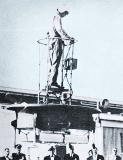 A lot of wild and zany ideas for flying
machines have been tried over the years. Most, if not all, of them could probably
be coaxed into flying with modern computer-controlled stabilization and navigations
systems that use fast-reacting powerplants, sensitive accelerometers and position
sensors. For anything other than stable platforms, human pilots just could not provide
control - at least on an extended basis and under adverse weather conditions. This
"flying platform"
by Hiller Helicopters is one such example. It appeared in the May 1957 issue of
American Modeler magazine. Piloting it was essentially the same as with the Lunar
Lander... A lot of wild and zany ideas for flying
machines have been tried over the years. Most, if not all, of them could probably
be coaxed into flying with modern computer-controlled stabilization and navigations
systems that use fast-reacting powerplants, sensitive accelerometers and position
sensors. For anything other than stable platforms, human pilots just could not provide
control - at least on an extended basis and under adverse weather conditions. This
"flying platform"
by Hiller Helicopters is one such example. It appeared in the May 1957 issue of
American Modeler magazine. Piloting it was essentially the same as with the Lunar
Lander...
 Some companies
have expressed an interest in being able to target Airplanes and Rockets via the
Google
AdSense program. Yes, it is possible to do that. As you might expect, finding
the exact information on the Google AdSense website is a bit difficult. This short
video does a good job summarizing exactly how to implement the "Ad Targeting" option,
then "Placements," and then add "Websites." Just enter airplanesandrockets.com
. There are other settings to optimize your advertising campaign with keywords (both
included and excluded), pricing, scheduling, statistical data collection and reporting,
etc. If you are currently using Google AdSense, then please consider this method,
and if you are not using AdSense, now would be a good time to look into it. I have
had reports from some companies that experience great results using AdSense (not
just on Airplanes and Rockets)... Some companies
have expressed an interest in being able to target Airplanes and Rockets via the
Google
AdSense program. Yes, it is possible to do that. As you might expect, finding
the exact information on the Google AdSense website is a bit difficult. This short
video does a good job summarizing exactly how to implement the "Ad Targeting" option,
then "Placements," and then add "Websites." Just enter airplanesandrockets.com
. There are other settings to optimize your advertising campaign with keywords (both
included and excluded), pricing, scheduling, statistical data collection and reporting,
etc. If you are currently using Google AdSense, then please consider this method,
and if you are not using AdSense, now would be a good time to look into it. I have
had reports from some companies that experience great results using AdSense (not
just on Airplanes and Rockets)...
 Even
though the U.S. Army Air Force and other research agencies around the world were
at the forefront of experimenting with remote control airplanes, helicopters, tanks,
trucks, cars, boats, and rockets, hobbyists were forging their own paths in the
electronic art. I did not know until reading this article that drones were flown
through the radiation field at the Bikini Atoll atom bomb test site for data collection.
In fact amateur radio operators have long had the privilege of broadcasting for
the purpose of remotely controlling a vehicle - the only scenario of Earth-based
transmission whereby the "control operator" is not required to identify his/her
call sign at an interval prescribed by the FCC (currently at least once every 10
minutes and at the end of the broadcast). Vintage modeling magazines have articles
on early
radio controlled (R/C) airplane experimentation. Target drones subject to remote
control were not just small models, but also full-size aircraft that were deemed
not airworthy enough to carry a human crew... Even
though the U.S. Army Air Force and other research agencies around the world were
at the forefront of experimenting with remote control airplanes, helicopters, tanks,
trucks, cars, boats, and rockets, hobbyists were forging their own paths in the
electronic art. I did not know until reading this article that drones were flown
through the radiation field at the Bikini Atoll atom bomb test site for data collection.
In fact amateur radio operators have long had the privilege of broadcasting for
the purpose of remotely controlling a vehicle - the only scenario of Earth-based
transmission whereby the "control operator" is not required to identify his/her
call sign at an interval prescribed by the FCC (currently at least once every 10
minutes and at the end of the broadcast). Vintage modeling magazines have articles
on early
radio controlled (R/C) airplane experimentation. Target drones subject to remote
control were not just small models, but also full-size aircraft that were deemed
not airworthy enough to carry a human crew...
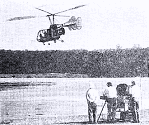 This angled, twin rotor, no-tail-rotor (NOTAR)
configuration for a remotely controlled helicopter was pioneered by
Kaman Aircraft Corporation in the 1950s, and is still a unique part of their
product lineup today. Per their website, "The Unmanned Aerial Truck (UAT) continues
a Kaman tradition of pioneering unmanned helicopters. In 1957, Charles Kaman, founder
of Kaman Corporation, created the first pilotless aircraft." The embedded video
below is a 1957 edition of the "You Asked for It" television show, where host Jack
Smith reported on a demonstration of the craft. It is amazingly stable and easy
to fly, by a pilot in the cockpit, from a ground-based remote control station, or
from a remote control unit located in another airborne helicopter. As you will see,
this probably qualifies as the first practical first-person-view (FPV) remote controlled
aircraft... This angled, twin rotor, no-tail-rotor (NOTAR)
configuration for a remotely controlled helicopter was pioneered by
Kaman Aircraft Corporation in the 1950s, and is still a unique part of their
product lineup today. Per their website, "The Unmanned Aerial Truck (UAT) continues
a Kaman tradition of pioneering unmanned helicopters. In 1957, Charles Kaman, founder
of Kaman Corporation, created the first pilotless aircraft." The embedded video
below is a 1957 edition of the "You Asked for It" television show, where host Jack
Smith reported on a demonstration of the craft. It is amazingly stable and easy
to fly, by a pilot in the cockpit, from a ground-based remote control station, or
from a remote control unit located in another airborne helicopter. As you will see,
this probably qualifies as the first practical first-person-view (FPV) remote controlled
aircraft...
 I
finally got around to scanning selected content from the 1986 issue of The Old
Farmer's Almanac. The "Old and New Mathematical Puzzles" feature was always my favorite,
so that's what is posted first. Difficulty levels are assigned as 1 for the easiest
to 5 for the hardest. Solutions are provided for levels 1 through 4, but level 5
(problems 12 through 15) problems were to be mailed in (no e-mail in the day) to
vie for a cash prize for providing the "best set of solutions," though I don't know
how one solution to these problems can be deemed "better" than another. Problem
#5 is interesting in that you must assign a value for the various numerical prefixes
and quantities. Sure, we all know what "atto" and "score" are, but what about "crore"
and "myriad?" I
finally got around to scanning selected content from the 1986 issue of The Old
Farmer's Almanac. The "Old and New Mathematical Puzzles" feature was always my favorite,
so that's what is posted first. Difficulty levels are assigned as 1 for the easiest
to 5 for the hardest. Solutions are provided for levels 1 through 4, but level 5
(problems 12 through 15) problems were to be mailed in (no e-mail in the day) to
vie for a cash prize for providing the "best set of solutions," though I don't know
how one solution to these problems can be deemed "better" than another. Problem
#5 is interesting in that you must assign a value for the various numerical prefixes
and quantities. Sure, we all know what "atto" and "score" are, but what about "crore"
and "myriad?"
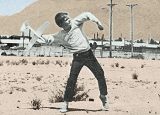 Website visitor Kenneth E. wrote to say
that he is working to build a complete collection of the Tenderfoot models that
were published in the Academy of Model Aeronautics' American Aircraft Modeler
magazine. The Tenderfoot series was an attempt to provide motivation to young newcomers
to the hobby. They were a mix of freeflight rubber powered airplanes and helicopters,
gliders, and ¼A & ½A control line designs that built quickly,
simply, and cheaply. Kenneth requested reprints of the following three models: the
½A C/L Saucerer from January 1970, the FF HLGs
Bonanza and Mustang
(this article) from January 1971, and the FF rubber Clodhopper from February 1973... Website visitor Kenneth E. wrote to say
that he is working to build a complete collection of the Tenderfoot models that
were published in the Academy of Model Aeronautics' American Aircraft Modeler
magazine. The Tenderfoot series was an attempt to provide motivation to young newcomers
to the hobby. They were a mix of freeflight rubber powered airplanes and helicopters,
gliders, and ¼A & ½A control line designs that built quickly,
simply, and cheaply. Kenneth requested reprints of the following three models: the
½A C/L Saucerer from January 1970, the FF HLGs
Bonanza and Mustang
(this article) from January 1971, and the FF rubber Clodhopper from February 1973...
 This
Nufnut free flight model airplane article and plans came to being in response
to laments from would-be model airplane builders who tried and failed at their first
(and sometimes more) attempts to make and fly something even as simple as a rubber
powered model. The author decided to present detailed instructions on building and
covering an open frame stick and tissue model, being sure to detail areas that generally
cause the most trouble. The most difficult task for most beginners is covering the
airframe with tissue and then obtaining a warp-free structure after application
of dope. If you are new to the hobby and either have experienced such disappointments
or are considering getting into the fine hobby of model airplane building and flying
and seek sage advice on how to avoid discouraging pitfalls, then you have come to
the right place. Tufnut is a somewhat unique design with its solid balsa fuselage
that has a slot cut in it for containing the rubber band, rather than just using
a stick with the rubber hanging underneath... This
Nufnut free flight model airplane article and plans came to being in response
to laments from would-be model airplane builders who tried and failed at their first
(and sometimes more) attempts to make and fly something even as simple as a rubber
powered model. The author decided to present detailed instructions on building and
covering an open frame stick and tissue model, being sure to detail areas that generally
cause the most trouble. The most difficult task for most beginners is covering the
airframe with tissue and then obtaining a warp-free structure after application
of dope. If you are new to the hobby and either have experienced such disappointments
or are considering getting into the fine hobby of model airplane building and flying
and seek sage advice on how to avoid discouraging pitfalls, then you have come to
the right place. Tufnut is a somewhat unique design with its solid balsa fuselage
that has a slot cut in it for containing the rubber band, rather than just using
a stick with the rubber hanging underneath...
 It's a good bet that many modelers, myself
included, have dreamed about
owning a hobby shop. How nice it would be to spend our days amongst
walls, shelves, and display cases filled with every type of modeling kit and accessory.
Melanie and I actually looked into buying one when we lived in Colorado Springs
in the early 1990s. It's a good thing we didn't in retrospect, given the way the
local hobby shop (LHS) has suffered tremendously since Internet-based purchases
have become so popular - especially being tax-free in most areas. There are still
big hobby shops left, but they are few and far between. I'm as guilty as the next
guy for not doing more to support my LHS, but usually it's for convenience sake
more so than price and not paying sales tax. This article from the November 1962
edition of American Modeler magazine, a time when local hobby shops were
still the rule rather than the exception, is a humorous "day in the life of a hobby
dealer." You can just imagine how plausible the scenario might be... It's a good bet that many modelers, myself
included, have dreamed about
owning a hobby shop. How nice it would be to spend our days amongst
walls, shelves, and display cases filled with every type of modeling kit and accessory.
Melanie and I actually looked into buying one when we lived in Colorado Springs
in the early 1990s. It's a good thing we didn't in retrospect, given the way the
local hobby shop (LHS) has suffered tremendously since Internet-based purchases
have become so popular - especially being tax-free in most areas. There are still
big hobby shops left, but they are few and far between. I'm as guilty as the next
guy for not doing more to support my LHS, but usually it's for convenience sake
more so than price and not paying sales tax. This article from the November 1962
edition of American Modeler magazine, a time when local hobby shops were
still the rule rather than the exception, is a humorous "day in the life of a hobby
dealer." You can just imagine how plausible the scenario might be... |



